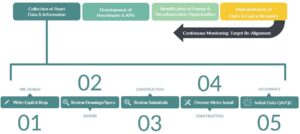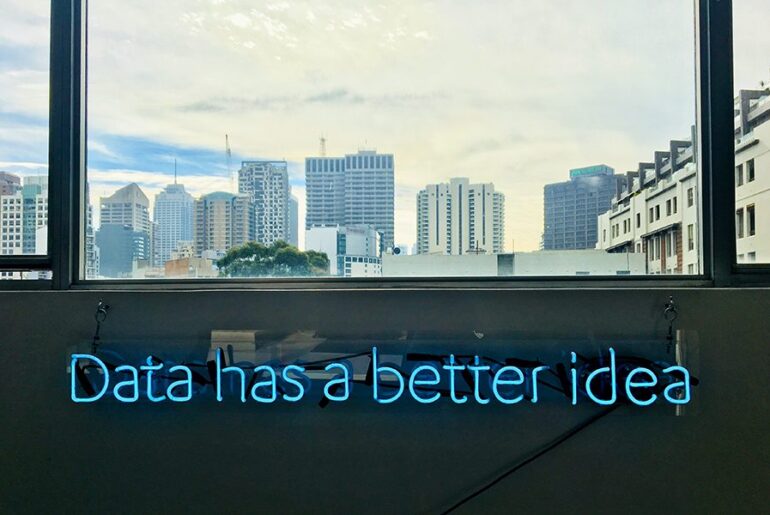This blog post was co-authored by Stok’s Ally Duncan and Jessica Shaw, summarizing their presentation at AEE West 2023.
We’re all too familiar with the headlines from states, countries, and corporations announcing their zero carbon targets; however, there’s confusion and vagueness surrounding what the target means and how it will be achieved. As building owners and occupiers adopt zero commitments and find their properties subject to energy performance and emissions regulations, the question becomes, ‘how can we achieve these ambitious reduction targets?’
In the built environment, quality assurance and control processes like measurement and verification (M&V) and monitoring-based commissioning (MBCx) require real-time, accurate data and provide insights that are foundational to achieving zero carbon targets. In this overview, we share how building performance monitoring, which encapsulates any process that continuously analyzes building data related to energy consumption, enables the achievement of decarbonization goals, and provide transparency to common points of confusion around M&V and MBCx.
M&V vs MBCx
To establish a common understanding, let’s begin with a high-level distinction between M&V and MBCx. For context, we acknowledge that LEED (Leadership in Energy and Environmental Design) has popularized the pursuit of M&V, MBCx, and advanced energy metering, which has only driven the industry toward capturing real-time, meaningful data on assets. However, because of how the M&V credit has evolved from LEED version 2.0 and LEED 2009 (v3) to what it is currently, MBCx in LEED v4, the terms and their underlying processes are commonly conflated.
-
- Measurement and Verification (M&V) generally refers to the installation of submeters and the consumption/demand of all incoming energy sources onsite. M&V tells you how much energy is used and can be grouped together by load type and energy end-uses including HVAC, plug loads, lighting, electric vehicle charging (EVs), photovoltaics (PV), elevators, and any large equipment like chillers, air handling units, boilers, and pumps.
The term M&V was popularized by early versions of LEED requiring that the IPMVP (International Performance Measurement and Verification Protocol) framework be used. As LEED 2009’s sunset date was June 30, 2022, the use of IPMVP for M&V purposes is being phased out. We acknowledge that there are four IPMVP options, which vary in applicability depending on the type of measurement boundary needed whether the project is new construction or an existing retrofit. There are opportunities to use the IPMVP guidance for energy efficiency retrofits; however, understanding the project goals is critical to applying the most effective approach. Finally, feedback from our clients indicated that they prefer to understand how their buildings are performing, and not just the calculated IPMVP savings of their building compared to an ASHRAE compliant building.
-
- Monitoring-Based Commissioning (MBCx) refers to not only reviewing the submeter data, but also including the detailed equipment or system operational data from sensors installed within the systems (i.e., HVAC air and water side, plumbing, lighting system, automated plug load systems, air quality data, occupancy data) that communicate back to the building automation system (BAS). MBCx provides detailed insight into what is using the energy and why, which enables actionable solutions. Through the lens of LEED, M&V has and is transitioning to MBCx in LEED v4.
An effective analysis approach that utilizes the value of both data sets – submeter and BAS data – first reviews the submeter data for any anomalies and leans on the findings to then review specific equipment data from the BAS to determine where the issue originates from and what it is. This approach avoids unnecessarily analyzing all the detailed system data and only focuses on the data with anomalies.
LIMITATIONS OF UTILITY DATA
Why use submeter and BMS data? Utility data can support higher-level reporting, but alone it lacks the detail needed to drive proactive energy management and detailed reporting. Including both BAS and submeter data provides further insight into energy end-uses and helps isolate specific issues for rectification.
The reason that utility meters are not sufficient for M&V and MBCx is because they are net meters: they only provide what is being purchased from the grid and any excess production that is sent back to the grid (properties with onsite solar). In short, utility meters provide the offset between consumption and production. To accurately quantify how much electricity the building is consuming and how much the PV system is producing, a whole-building submeter and a PV submeter are required as the minimum submetering to understand consumption vs production. Additional submeters are still required to understand how energy is being used among the energy end-uses or, for example, why higher than average spikes are occurring on certain days.
A COMPREHENSIVE APPROACH TO BUILDING DECARBONIZATION
This high-level process for decarbonization planning can be applied to new construction or existing retrofit projects allowing owners, operators, and project teams to monitor the health of their properties and accurately forecast how to achieve energy and carbon targets.

The collection of energy related data for the property lays the foundation for the rest of the process: developing accurate benchmarks and goals, identifying opportunities for optimization, implementing the measures, and continuous monitoring to ensure target alignment.
Highlighting a data collection challenge: dependent on your role, various roadblocks will likely be encountered in obtaining thorough and accurate energy consumption data. For building owners and operators, obtaining tenant consumption may be difficult without a mechanism requiring it like green lease language. For tenants, obtaining the portion of base building energy associated with your space is challenging, without access to the BAS data or detailed submetering on the tenant’s part.
Stok’s process for ensuring accurate data is collected is outlined in detail below while following the project phases 01 through 05 in the diagram above. It’s highly recommended to engage
-
- [Solicitation] Develop explicit requirements. Define the Owner’s expectations on submetering energy end-uses, BAS trending and points, and informational dashboards.
- [Design] Develop a monitoring strategy and plan. Confirm that the strategy is implemented throughout the design process by reviewing drawings, the sequence of operation, and specifications.
- [Construction] Confirm installation of submeters and integration of data to BAS. Provide an initial review of the data to verify it is thorough, points and meters are uniquely named, and there are no data gaps.
- [Occupancy] Gather utility, submeter, and applicable BAS data. After occupancy has been established and systems have settled into normal operation, review the data monthly or quarterly for at least one year, identifying any issues and working with the owner to resolve them.
STAKEHOLDERS’ ROLES
Each stakeholder has a critical role to support the achievement of the project’s energy or carbon goals through monitoring. Contractor, designer, and operator involvement early in the process is key to achieving the owner or occupier’s goals, but what does this look like in practice? Below are a few significant examples for each stakeholder:
For Designers: Monitoring strategies start in pre-design to minimize the quantity of necessary submeters and sensor points. Once an owner establishes their project goals – such as LEED certification, Living Building Challenge, Zero Net Energy (ZNE), or another zero commitment – the goals should be translated into the necessary monitoring strategy that will achieve and authenticate that goal. The monitoring strategy must be communicated through design and construction and into occupancy via the Owners Project Requirements (OPR), Basis of Design (BOD), drawings, specifications, and submittals.
For Contractors: To support accurate submetering, ensuring electrical panels are segregated by load type and remain divided as much as possible is critical. A mixed end-use panel will require a branch circuit meter in addition to the total panel meter to capture the individual circuit that is of a different end use from the rest of the panel. Controls programming will require calculations to remove the outlying circuit and separate it by end use once more. The more of these calculations that are required, the more likely there will be issues in the data and troubleshooting required during the occupancy phase. Note that this isn’t typically an issue in California because Title 24 requires segregated panel loads, but there are instances where panels will become mixed during construction.
To support BAS point integration, the MBCx agent should provide an initial review of the point-to-point diagramsequence of operation, and trended data to verify the data is accurate and most valuable to the operator. Some of the most common issues include data points with incorrect units, non-unique point or meter names, points that accurately represent the sensor in the field, points with all zero data, and points with no data or large data gaps. The controls and electrical contractors work closely with the MBCx agent to correct issues.
For Operators: If submeter data is available by energy end-use, this can be reviewed for simple anomalies; however, if BMS data is also evaluated, the anomaly can be traced back to one or more pieces of equipment. At this point, the operator can proactively identify savings opportunities. It’s essential to identify and resolve issues as soon as they occur to minimize their impacts on the performance of the property, especially if the property has a zero energy or carbon commitment as it can quickly become derailed.
IN CONCLUSION

This building performance monitoring approach grounds sky-high targets in real-time data and sets owners and occupiers up for success. Just as an EKG tracks the pulse of your heart, building performance monitoring aims to get a pulse on your building and track the health through its lifecycle. The best way to do that is by implementing monitoring strategies that include ongoing M&V and MBCx with regular data reviews. Get in touch to start tracking the health of your building through data.




